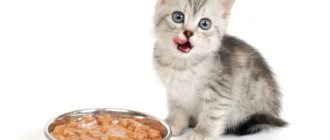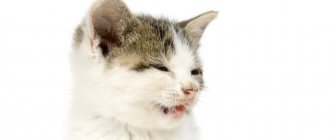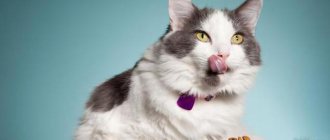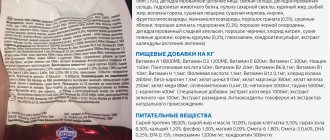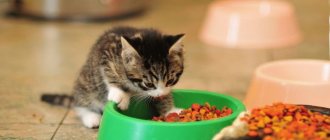Is it possible to give dry food to a kitten?
For full growth, development, and health, kittens must receive a varied diet that is fully balanced in nutrients. It is equally important to adhere to the rules and feeding regimen.
The basis of a cat's diet should be meat products. In addition, they should receive plant proteins, essential amino acids, macro- and microelements, and vitamins. Useful substances are found in cereals, fermented milk and dairy products, herbs, and vegetables.
The main nutrition of newborns and small kittens is mother's milk. But if it so happens that the babies had to be taken away from their mother early, then when transferring to artificial nutrition, the pets need to be given high-quality milk formula. Grown-up kittens should also receive meat complementary foods (low-fat boiled meat, minced meat).
Feeding kittens dry food
New foods should be introduced gradually into the kittens’ diet. Otherwise, you can provoke food allergies and digestive disorders. New foods should be given in small portions, gradually increasing their volume, but reducing the frequency of feedings. At the same time, carefully monitor the condition of the kitten.
Ready-made food, which is available in a wide range today, can be given to kittens, but it is necessary to choose products from trusted brands and brands of the premium, extra, and super premium categories. If your pet received natural complementary foods up to 3–4 months, then you should gradually introduce him to ready-made food or canned food.
Important! Give dry food for kittens in a soaked form at least for the first time, until the animal’s gastrointestinal tract gets used to the new food. Buy ready-made food designed specifically for kittens.
According to veterinarians, it is worth starting to feed a kitten with ready-made formulas at three to four months, although there are canned foods on sale intended for one-month-old kittens. Up to two months, as a rule, babies are fed by a cat, but from this age you can give babies additional complementary foods. A well-fed kitten sleeps peacefully or quietly sucks on its mother cat, but if the kittens squeak, crawl around their mother, refuse the nipple, or greedily grab an outstretched finger - these are signs that the babies are hungry. This means that they need to be fed either with formula milk substitutes for natural milk, or with ready-made food for kittens.
Milk replacer for kittens
Switching to another food after a “hunger strike”
The most effective way to still achieve success is to give your cat preventative fasting. Naturally, this is not done for the purpose of “punishment,” because there are no monsters or sadists among us, but only for the benefit of the animal. But if suddenly seditious thoughts arise in your head, pushing you to capitulate into the clutches of a tailed tyrant, then remember: not a single cat has ever died from exhaustion in front of a bowl full of food.
Remind yourself often that cats, especially indoor and sterilized ones, even benefit from fasting fasting days - they help prevent them from gaining excess weight.
So, the essence of the procedure is simple: remove the bowl for a day and do not give the cat any food, even if she really asks for it. The next day, place a bowl with new food. Many advise at this moment not to embarrass the animal and not to stand around it with the whole family waiting for a “miracle” - a proud tailed animal may not like public admission of defeat in the war for food.
In general, the period of transfer to another diet using fasting depends on the stubbornness of a particular representative of the cat family, but should not exceed three days, otherwise there is a risk of harm to the health of the animal. Remember that the cat must have access to water at all times.
None of the cat owners is immune from the possible need to change their purring cat’s usual diet. The circumstances that force you to change your usual feeding are not as important as knowing how to switch a cat to a different food.
The reasons for changing the power supply may be
:
- the animal has an allergy to dry or, conversely, natural food
- intolerance to one of the components of the feed
- lack of nutrients or microelements.
In some cases, replacing food is associated with a change in the financial condition of the owner, due to which the cat can no longer receive the usual expensive food. Thus, the financial crisis also affects cats, who are forced to switch to alternative food sources.
How often should you feed a kitten?
Feeding kittens must be properly organized. It is very important that the kitten is always full, but does not overload its digestive system. Overfeeding can cause digestive upset, disrupt metabolism, cause diarrhea, and systemic disruptions in the body.
Important! If the feeding regimen is correct, the babies will develop well and gain weight quickly. The feeding frequency should be approximately twice the feeding frequency of an adult cat.
By the age of two months, a kitten should eat five to six times a day. This is due to the fact that their small tummy is not able to accommodate much food. In addition, we should not forget that the gastrointestinal tract is not completely populated with beneficial microorganisms responsible for digestive processes. Therefore, kittens should be fed in small portions. Food is given at the same time.
When the kitten grows a little and reaches the age of three months, the frequency of feedings can be reduced to four times, while slightly increasing the portion of food or ready-made food.
When the kitten is six to seven months old, the frequency of feedings is gradually reduced to three times a day. At the age of 8–9 months, you can switch your pet to two meals a day.
How long will it take to change food?
Ideally, owners who are patient enough have up to ten days to gradually change the cat’s usual food to a new one.
In order to injure the animal as little as possible, the transfer is carried out gradually. Initially, in the first days, about 25% of new food is added to the animal’s diet. When, after eating several times, the cat becomes accustomed to the innovation, the amount of new food is increased to 50%. After a week of changing the diet, the new food may well account for three-quarters of the total amount of food. Thus, day after day, increasing the amount of new food, we ensure that the animal switches from its usual food to a new one. However, unfortunately, for many owners of particularly capricious animals, everything does not go so smoothly. What to do in this case?
Which food to choose, from what month can kittens be given dry food?
Starting from 2–3 months, kittens can be fed both wet canned food and dry food. The finished food should contain no more than 35% protein and no more than 20–25% fat. Superpremium and premium food, as well as holistic food, are as close in composition as possible to natural food. These are the products you should choose for a 3-4 month old kitten.
Quality cat food
Important! Cheap low-grade canned food and dry mixtures contain a large amount of synthetic additives, mineral salts, flavorings, dyes, stabilizers, which can cause poisoning, nutritional allergies, and problems in the functioning of the digestive tract.
The best dry food for kittens:
- Eukanuba Puppy & Junior Small Breed;
- Hill's Science Plan Puppy & Kitten;
- Royal Canin Size Nutrition Mini Junior.
The products of these brands are recommended to owners of mustachioed pets by veterinarians, felinologists, and experienced cat breeders. It has the most balanced composition, contains useful components, natural ingredients and substances necessary for the baby’s body.
Royal Canin cat food
The kitten can be given super premium Akana food. It has a completely balanced composition and an affordable price. The main ingredients are chicken, lamb, salmon. Does not contain grains, therefore suitable for cats with allergies. The line includes wet and dry mixtures for animals of various age groups and breeds.
What foods should not be given to kittens? This question is also often found on thematic forums. You should not feed kittens with Whiskas, Frieskies, Kitekat, Katinka, economy class products, or mass market food.
Wet food, canned food for kittens
According to veterinarians, canned food, spiders, and wet food, which consist of 80% water, are more suitable for small pets, since they are completely absorbed in the gastrointestinal tract and do not injure the esophagus. But before giving food to a 3-4 month old kitten, be sure to warm it up a little. Immediately after the kitten has eaten, place uneaten wet food in the refrigerator until the next feeding.
The best wet food for cats and kittens:
- Bosch Sanabelle (Germany).
- Pro Plan Junior.
- Hills.
Brit wet food
The above foods contain all the necessary components, have a balanced composition and an affordable price.
The final trick
If your pet begins to show character and completely refuses to eat, you can attract his attention simply by soaking the dry food in boiling water. This way its consistency will be much more familiar, and the increased smell will attract attention.
Last but not least, be sure to monitor your purr's health throughout the diet change period, and if you notice any unwanted effects such as vomiting, diarrhea, or coat problems, contact your veterinarian to find the source of the problem. It is quite possible that the animal’s body reacts this way to one of the components in the composition. In this case, the specialist will suggest a brand that is better suited than the one you have chosen.
Consequences of improper feeding
If the kitten’s diet is unbalanced and poor, then the babies will lag behind in growth, development, and gain weight poorly. A deficiency of beneficial components (minerals, vitamins, amino acids) can cause:
- decreased immune potential, resistance;
- hypovitaminosis;
- poisoning;
- indigestion;
- endocrinological pathologies;
- food allergies.
Having chosen ready-made dry food for kittens, you should not change it for another. Each brand has its own blend, balanced composition. By making a cocktail out of feed, you risk introducing an imbalance into the body. Therefore, the kitten should eat dry food, canned food, and spiders of only one brand.
Food allergies
Disadvantages of industrial food
Dry granules, although very useful for kittens, nevertheless have some disadvantages:
The need for careful adherence to the drinking regime. No matter how high-quality the food is, it does not contain moisture, and therefore you need to carefully ensure that your pet drinks enough water. On average, the amount of liquid drunk per day is 150-200 ml. Lack of water can result in the further development of urolithiasis and a number of other health problems. There should always be fresh, clean water in the bowl; it should be changed 2 times a day.
Cheap economy category food does not have the required balance of nutrients. As a rule, their concentration of carbohydrates is very high. Regular consumption of such food can provoke the development of obesity and increase the risk of diabetes.
Negative effect on teeth. There is an opinion that granules are very useful for kittens' teeth. But it is not so. Despite the sharpness of the teeth, dry food is not their natural food. When chewing granules, teeth are subjected to severe stress. This can lead to plaque buildup
If the kitten eats only dry, solid food, the owner should pay attention to caring for the pet's teeth.
If you follow all the recommendations for feeding a kitten with industrial food, all the shortcomings and possible complications associated with them can be prevented.
Typical mistakes of owners
Some owners believe that healthy food for humans is also suitable for animals. This leads to the fact that cats receive food from the table with a high content of salt, starch, sugars and other components that are strictly contraindicated for pets.
In addition, there are a number of products that are life-threatening for pets. These include:
- economy class diets for animals;
- fatty, smoked, canned meat or fish products;
- all types of pork;
- some varieties of cereals and corn in any form;
- chocolate and other sweets, including cakes and candies;
- cream, butter, full-fat dairy products.
Read about what cats should not eat.
Tubular bones of boiled poultry, raw fish, and stale food can harm a cat’s gastrointestinal tract. It is strictly forbidden to give baked goods, salted and pickled foods to animals.
Meat and fish without heat treatment can lead to infection with parasites. We recommend reading the article on whether you can give your cat raw food.
Important Tips
The main rule is to maintain the health of the pet, so it is not worth conducting experiments on switching to alternative types of food without a veterinarian’s prescription. As a result of changes in diet, the animal's digestive system suffers.
The translation, carried out for the intended purpose, is carried out gradually and irrevocably. Owners need to be patient and persistent.
There are a number of recommendations that all cat owners should adhere to when switching to pelleted food:
- You cannot alternate dry, wet and natural products.
- Cheap diets can kill a kitten, so choose either super premium and holistic food, or natural food.
- Additional vitamins are not needed when feeding dry foods. They are excluded so as not to get an excess of one of the components - hypervitaminosis, and, as a result, an allergy to it.
